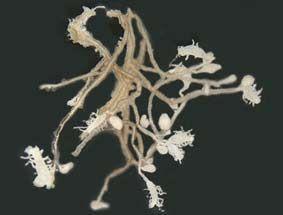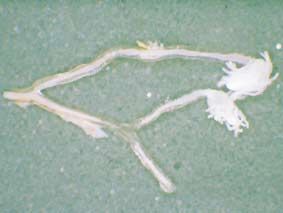Major Group: Cnidaria
Minor Group: Hydrozoa (Pennak 1989, ABRS 2004)
Order: Hydrozoa (Williams 1980) or Hydroida (Pennak 1989, ABRS 2004)
Family: Oceaniidae (formerly Clavidae)
Genus: Cordylophora
Species: caspia
This family is represented in Australian freshwaters by a single species, Cordylophora caspia Pallas. There is some discrepancy in the literature about the taxonomic level of Hydrozoa. This does not affect the identification of Clavidae. |
Descriptive Features: profusely branching, moss-like, colonial animals
feeding individuals are spindle-shaped with prominent manubrium and 10 – 20 thin scattered tentacles
reproductive polyps, gonophores, are ovoid
Size: 30 mm in height
|

|
Cordylophora caspia, colony |
|
|

|
Cordylophora caspia, colony |
|
Taxonomic Checklist: Cordylophora caspia Pallas |
|
Distribution: Eastern Australia
Sensitivity Rating: SIGNAL grade 3
Functional Feeding Group: predators |

|
Murray River estuarine, Hindmarsh Island SA |
|
|
Ecology: Instream habitat: Cordylophora caspia tolerates both fresh water and mildly saline waters. It occurs in still or flowing, inland or coastal waters.
Feeding ecology: All cnidarians are predators feeding on minute animals such as cladocerans and copepods. They catch their prey with tentacles armed with stinging nematocysts.
Habit: Cordylophora caspia individuals unite to form a colony structure.
Life history: |
| |
Information Sources: Williams 1980, Pennak 1989, Gooderham & Tsyrlin 2002 |
|
|
|